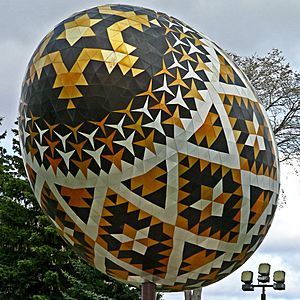Vegreville egg facts for kids
The Vegreville egg is a huge sculpture of a pysanka. A pysanka is a special Ukrainian-style Easter egg with beautiful designs. This amazing artwork was created by Paul Maxum Sembaliuk. It's made from many flat pieces of special, colored aluminum shaped like triangles and stars. These pieces are put together over an aluminum frame.
The egg is about 31 ft (9 m) long, which is as tall as a three-and-a-half-story building! It weighs about 2.5 t (5,512 lb). This makes it the second largest pysanka in the world. The biggest one is in the Kolomyia Pysanka Museum in Ukraine.
The town of Vegreville, in Alberta, Canada, asked for this sculpture to be built. Many people of Ukrainian heritage live there. The town got some money from the Canadian government to help build it. The egg was also made to celebrate the 100th birthday of the Royal Canadian Mounted Police in 1975. It honors Ukrainian culture in Canada, especially the early Ukrainian settlers near Edmonton.
The Vegreville egg is a popular stop for tourists traveling along the Yellowhead Highway. Thousands of visitors come to see it every year. You can find it in Elk's Park, on the north side of Alberta Highway 16A.
Contents
Designing the Giant Egg
The Vegreville egg was designed by Paul Maxum Sembaliuk. He is a Canadian artist with Ukrainian roots. Paul grew up near Vegreville. He worked with a computer expert named Ronald Resch to make his design real.
Choosing the Right Materials
When they first thought about building the pysanka, they considered many materials. These included concrete and wood. The town of Vegreville did not have much money for the project. So, Paul used his connections to get more support. He was a graphic artist for the Alberta government at the time.
Paul had worked on a big project using special colored aluminum before. He asked the company that made it, Permaloy, for help. Permaloy agreed to donate money and the special aluminum for the egg. Paul wanted to use this material because it is very strong. Also, its colors would not fade in the sun.
Using Computers for Design
The next challenge was figuring out how to use the aluminum for the egg. Paul's cousin, Dr. John Ruptash, was an engineering expert. He suggested using a computer to create the detailed drawings for the pysanka. Dr. Ruptash connected Paul with Dr. Ron Resch and his team at the University of Utah.
It can be very hard to figure out the math for an egg's surface. But Dr. Resch, a computer science professor, and his team solved the puzzle. They figured out how to put flat pieces onto a round, 3D egg shape. They even created special computer software to help. This was the first time a physical structure was designed completely with computer software!
How the Egg Was Built
Dr. Resch and his team used 1,108 identical triangles to cover the egg. They also used 524 star-shaped pieces. In total, there are 3,512 visible flat surfaces. It took 6,978 nuts and bolts to hold it all together! Inside, there are 177 support beams.
The aluminum pieces are thin, from about 1⁄16 in (1.588 mm) to 1⁄8 in (3.175 mm) thick. They are joined at different angles. The pysanka leans at a 30-degree angle from its base. It can also turn with the wind, just like a weather vane.
The computer software used to cut the egg's pieces was very advanced. Later, it was even used to help cut the outer tiles for the Space Shuttle.
Gallery




